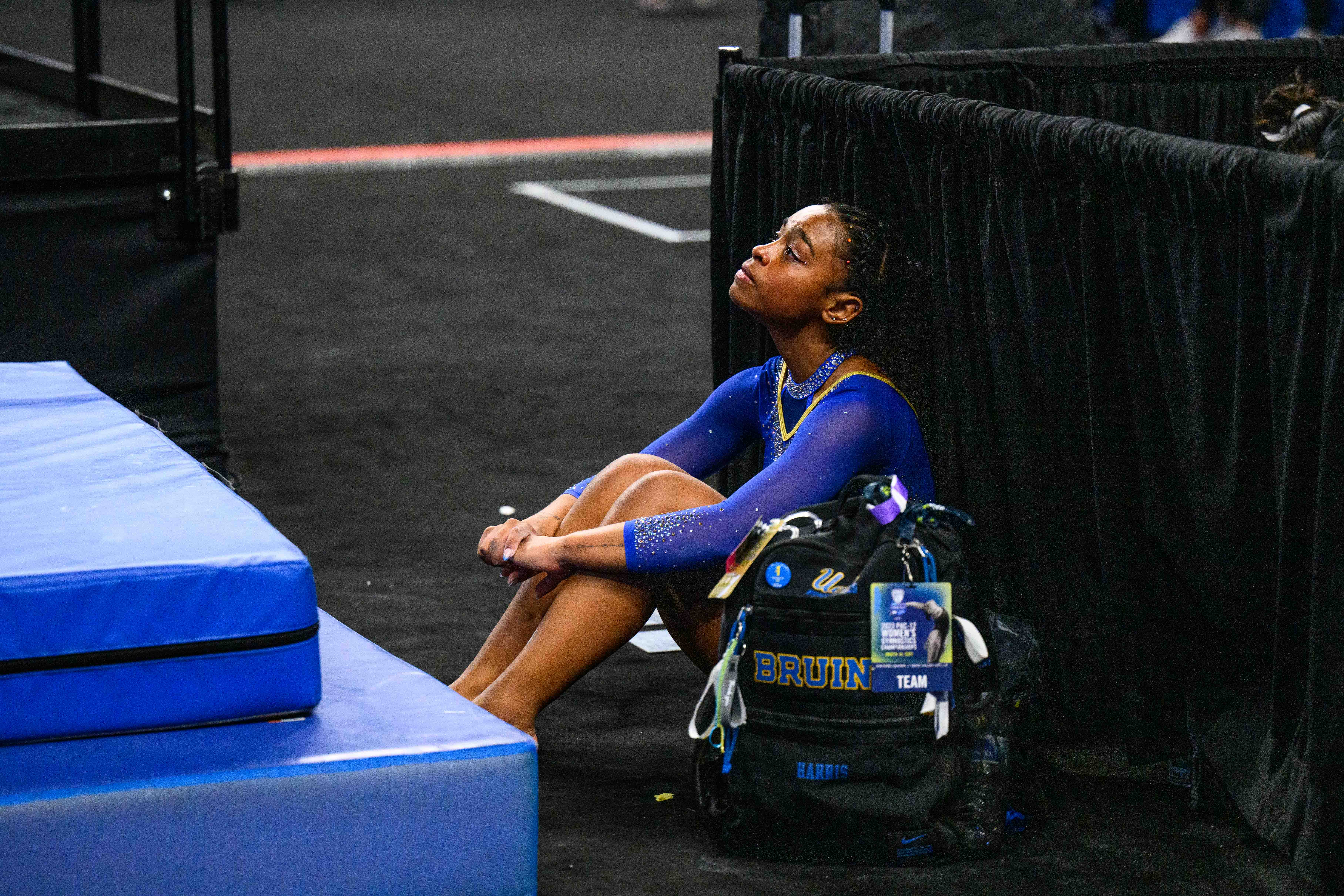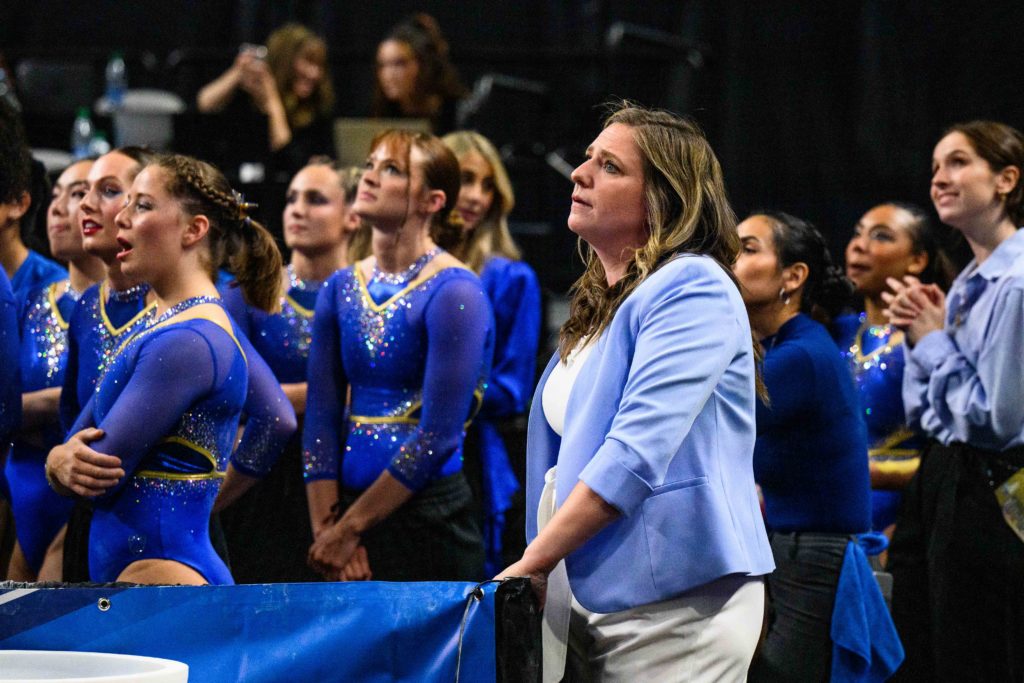Sam Settles It: UCLA’s early elimination shows why NCAA gymnastics should reseed before nationals

Freshman Selena Harris watches the leaderboard on the jumbotron. UCLA gymnastics failed to advance out of the NCAA semifinal round despite its score ranking third out of the eight teams that competed Thursday. (Anika Chakrabarti/Photo editor)

By Sam Settleman
April 15, 2023 10:13 a.m.
This post was updated April 16 at 10:39 p.m.
In sports, the best team doesn’t always win.
You could argue that’s what makes sports great. That’s what makes them unpredictable. That’s exactly why we watch.
That adage rang true during Thursday’s semifinal action at the NCAA gymnastics championships, but it highlighted a major flaw in the event’s format in the process. The eight teams at nationals compete in a pair of semifinal sessions, with the top two teams from each meet advancing to the NCAA final.
It’s a simple system that has its merits, but one that failed on the biggest stage Thursday.
LSU and Florida advanced out of the first semifinal with a 197.4750 and 197.4000, respectively. UCLA’s 197.9125 hours later had beaten both those scores by over four-tenths, but Utah and Oklahoma took first and second in the semifinal, knocking the Bruins out of the running.
UCLA’s score marked the highest-ever non-qualifying NCAA semifinal score by a decent margin, prompting questions as to whether or not the NCAA championships format should be reconsidered.
Two solutions have been floated in the aftermath. The first says to simply take the top four scores across the two semifinals, an idea even former Bruin and Olympic champion Madison Kocian put forth. The second says to reseed the eight remaining teams after the regionals round to ensure a more even distribution of top teams on both sides of the bracket.
The first solution would never work, but the second has serious potential.
Simply taking the top four scores of the eight teams competing seems like the perfect solution on the surface, but it has one fatal flaw: Scores between the first and second semifinals are notoriously much different. Over the last three years, nearly 90% of the individual champions have come from the night session of the NCAA semifinals.
Not to mention, the idea of the top two teams from the first semifinal not discovering their fate until later in the night seems detrimental to the competition aspect of the event.
Reseeding prior to nationals, on the other hand, would retain the win-or-go-home nature of the current format while also favoring the teams that had put up the biggest scores all season and through regionals. RoadToNationals, the predominant ranking system used in NCAA gymnastics, already deploys a new ranking after regionals that combines a team’s NQS from the regular season with its regional final score that advanced it to nationals.
The resulting system would be simple: rank the teams one through eight based on those scores and redo the bracket. The No. 1, No. 4, No. 5 and No. 8 seeds go head-to-head in one semifinal, while the No. 2, No. 3, No. 6 and No. 7 seeds occupy the other.
So where does that leave us in the last four championships since the Super Six format was phased out?
Based on this year’s post-regionals rankings, UCLA would have competed alongside Oklahoma, California and Denver on Thursday, easily advancing to the NCAA final with its 197.9125. On the other side, Utah would’ve taken the crown and moved on with second-place LSU. In other words, the top four scores – also the top two in each semifinal – would advance.
It’s still not a perfect system, however. In 2022, that system would’ve stopped a No. 7-seeded Auburn team and its breakout NCAA semifinal performance from moving on. The Tigers, however, finished last at the 2022 NCAA finals by a sizable margin, indicating maybe regular-season and regionals scores can in fact be an effective predictor of postseason performances.
In both 2019 and 2021, reseeding would have done the same as in 2023, advancing the top four NCAA semifinal scores to the final instead of sending home a third-place team with a better score than a second-place team.

A common argument against reseeding is that no other sport has such a system. March Madness isn’t equally fair in every corner of the bracket. Most other sports simply seed based on regular seasons and let the bracket run its course. Sometimes, the luck of the draw is just that – luck.
But even the NFL has some element of reseeding in its playoff format. After the wild card round, the top seed in each conference faces the lowest remaining seed in the divisional round. Matchups are not predetermined at the outset but are decided after the results of the first round.
And even if reseeding wouldn’t be truly comparable to any other postseason model, why should it be? NCAA gymnastics is a wildly different sport than most.
In football, basketball and almost any other sport in this conversation, there’s offense and defense. When you go head to head against a single opponent in those sports, you can’t make excuses about the luck of the draw when you lose.
When you lose a qualifying spot to a team that objectively performed significantly worse from a scoring standpoint, it’s an entirely different discussion. By the standards of a traditional sport, UCLA beat LSU and Florida, and yet, the Tigers and Gators are moving on instead of the Bruins.
There’s still the argument about second semifinal scores consistently outpacing scores from the first session. Could reseeding solve that problem? Probably not.
But that falls more into the category of the plague of judging inconsistencies throughout NCAA gymnastics, a much larger-scale problem that doesn’t have a simple solution.
When the sport’s coaches meet in May to discuss future changes, there will be a laundry list of items on the agenda after a season in which controversy, at times, downplayed the growth of NCAA gymnastics.
The first item on that agenda should be reseeding.

